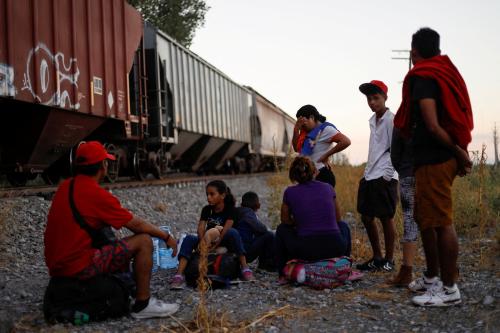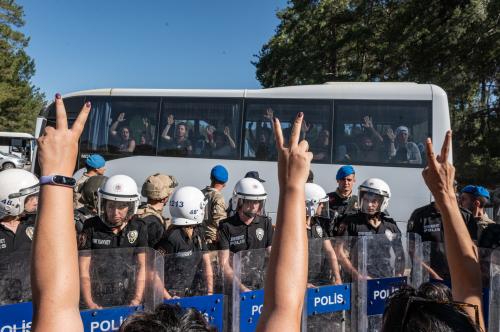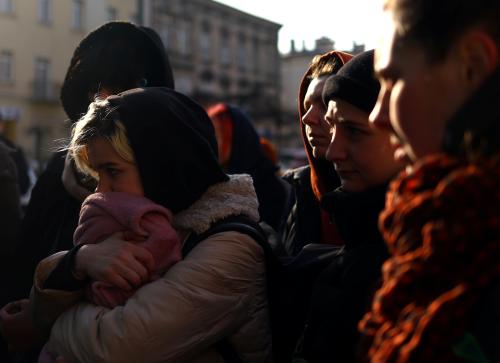In April 1998 the first international standards for internally displaced persons were introduced into the United Nations Commission on Human Rights. Entitled Guiding Principles on Internal Displacement, they were developed by a team of international lawyers under the direction of the Representative of the UN Secretary-General on Internally Displaced Persons. They set forth the rights of internally displaced persons and the obligations of governments and insurgent forces in all phases of displacement—before internal displacement occurs (that is, protection against arbitrary displacement), during situations of displacement, and in the return and reintegration phase. Although not a legally binding document like a treaty, they reflect and are consistent with international human rights and humanitarian law. They are the first attempt to articulate what protection should mean for the internally displaced and they give international and non-governmental organizations an important tool to use in their advocacy work on behalf of the displaced.
Origin of the Principles
The idea for the principles emerged from a study undertaken by a team of international lawyers at the request of the Representative of the Secretary-General. Both the UN Commission on Human Rights and the General Assembly had requested that the Representative explore the extent to which existing international law provides adequate coverage for internally displaced persons. Because governments by their actions frequently cause or tolerate internal displacement and are often unwilling or unable to meet the needs of the displaced, it was considered important to determine the degree to which international law provides an adequate basis for the protection of such persons. Internally displaced persons were understood to mean those forcibly uprooted from their homes by armed conflict, internal strife, violations of human rights, and human-made and natural disasters, but who remained within the borders of their own countries.
The completed study, entitled Compilation and Analysis of Legal Norms and presented to the Commission at its 1996 session, examined international human rights law, humanitarian law, and refugee law by analogy, and the extent to which each meets the basic needs of the internally displaced. While it found that existing law provides a good deal of coverage for the internally displaced, it also found significant areas in which the law fails to provide sufficient protection. Four categories of gaps were identified.
The first were called “normative gaps”, where international law fails to provide any protection at all for particular needs. For instance, the law is silent on restitution of property lost as a consequence of displacement during internal or international armed conflict or to compensation for its loss. Second, there are “applicability gaps.” In this case, a legal norm exists but it is not applicable in all circumstances. In some situations of tensions and disturbances, for example, humanitarian law does not apply while human rights law may be derogated from, thereby suspending protections critical to the well-being or survival of the displaced. Human rights law, moreover, does not generally apply to non-state actors, so that internally displaced persons may be left with minimal legal protection in situations where humanitarian law does not apply and where violations are committed by non-state actors. With respect to refugee law, while some of its principles may be applicable to the internally displaced by analogy, the protection accorded refugees under the 1951 Refugee Convention cannot apply directly to internally displaced persons, even though their conditions are similar.
There are also “consensus gaps.” In these cases, a general norm exists but a more specific right to give effect to that norm has not yet been articulated. For example, while there is a general norm prohibiting cruel and inhuman treatment, there is no explicit prohibition against the forcible return of internally displaced persons to places of danger. Existing case law, as legal experts Walter Kälin and Robert K. Goldman point out, refers only to return across international borders, which necessitates the articulation of “a prohibition of inhuman return of internally displaced persons to dangerous areas within their own countries.” Another example is provided in the case of the prohibition of arbitrary detention. Although this norm is clearly recognized, “the preconditions for lawful detention of internally displaced persons in closed camps are unclear.”
Finally, there are “ratification gaps.” Some states have not ratified key human rights treaties or the Geneva Conventions and their Additional Protocols, and are therefore not formally bound by their provisions unless they are reflective of customary law. In its conclusion, the Compilation and Analysis identified seventeen areas of insufficient protection owing to inexplicit articulation and eight areas of clear gaps in the law. To remedy these, it suggested that any future restatement of the law should include a specific prohibition against the forced return of internally displaced persons to places of danger. It called for specific protections for internally displaced women and children. It urged clarification of and restrictions on the lawful detention of internally displaced persons in closed camps. It recommended the articulation of a right to restitution or compensation for property lost as a consequence of displacement in situations of armed conflict, and recognition of the need of the displaced for personal identification, documentation and registration. It also indicated the need to recognize an explicit obligation of governments to accept offers of humanitarian assistance and to protect relief workers, including their transports and supplies. Its findings clearly pointed to the need to restate general principles of protection in more explicit detail and to address the gaps in the law in order to enhance protection for the internally displaced.
The Development of Guiding Principles
A body of principles was decided upon as the most realistic possibility. The Commission on Human Rights had requested the Representative to develop an “appropriate framework” based on the Compilation and Analysis, but it had carefully avoided the term “legal” framework in making its request. A glut of international instruments on different subjects could already be found before the world body. Better implementation of existing law rather than a new instrument was considered essential. Moreover, international organizations such as the ICRC expressed reservations that a new legal instrument could interfere with or undermine the Geneva Conventions and the extensive coverage they provide.
There was nonetheless general agreement that the norms applicable to the internally displaced should be consolidated into one document. Both international organizations and NGOs argued for a compact, useable document to guide their work in the field with the internally displaced. A body of principles, it was felt, could also help governments to develop national law for the protection of internally displaced persons. Whereas a myriad of provisions could be found in international human rights and humanitarian law and in refugee law by analogy, too often it proved difficult clearly to determine which guarantees applied in a specific circumstance. An authoritative document of the rights of the displaced would help clarify this problem. The preparation of guiding principles was endorsed by both ICRC and UNHCR.
The restatement of the law through principles, it came to be agreed, could reinforce and strengthen existing protections. Restatement could also address the gaps and gray areas in the law identified in the Compilation and Analysis. Fears that the principles would have the effect of discriminating against other groups were also allayed. It was pointed out that precedents abound in international law for special protections for disadvantaged groups, whether refugees, minorities, indigenous populations, the disabled, women or children. A body of principles tailored to the needs of the internally displaced would seek to ensure that internally displaced persons, like others, are protected and their unique needs acknowledged and addressed.
At the same time, it should be emphasized that a body of principles does not create a new legal status for internally displaced persons. The internally displaced are within their own countries and enjoy the same rights and freedoms as other persons in their countries. There are certain needs, however, that internally displaced persons have by virtue of their displacement which the principles seek to address. Displacement, after all, breaks up the immediate family. It cuts off important social and cultural community ties; terminates stable employment relationships; precludes or forecloses formal educational opportunities; deprives infants, expectant mothers and the sick of access to food, adequate shelter or vital health services; and makes the displaced population especially vulnerable to acts of violence, such as disappearances, rape and attacks on their encampments. Too often the displaced fall into a vacuum of responsibility within the state and are targeted and subjected to persecution and harassment. Principles are needed to address their special needs by identifying the rights and guarantees relevant to their protection.
Content of the Guiding Principles
The principles apply to three different situations—tensions and disturbances, which are covered by human rights law; non-international armed conflict, covered by both humanitarian and human rights guarantees; and interstate wars where humanitarian law is primarily operative. The guarantees that have to be observed in all three situations are identified as well the safeguards specific to particular situations.
The beginning section of the Guiding Principles, which sets forth protection against arbitrary displacement, is one of the more innovative. While international law relating to armed conflict and to indigenous peoples expressly prohibit arbitrary displacement, in human rights law by contrast this prohibition is only implicit in certain provisions. The principles therefore specify the grounds and conditions by which displacement is not permissible and the minimum procedural guarantees to be complied with, should displacement occur. They make clear, for example, that displacement is prohibited “when it is based on policies of apartheid, ‘ethnic cleansing’ or similar practices aimed at or resulting in altering the ethnic, religious or racial composition of the affected population.” They also consider as arbitrary displacement “cases of large-scale development projects, which are not justified by compelling and overriding public interests.” They further make clear that displacement should not be carried out in a manner that violates the rights to life, dignity, liberty, or the security of those affected. States, moreover, have a particular obligation to provide protection against displacement to indigenous peoples and other groups with a special dependency on and attachment to their lands. The principles relating to protection from displacement are based on a special study submitted by the Representative of the Secretary-General to the Commission on Human Rights in 1998.
The section relating to protection during displacement articulates the specific rights needed by internally displaced persons to give effect to general norms. For example, after affirming the general norm that every human being has the right to recognition as a person before the law, the principles provide that the authorities concerned shall issue to internally displaced persons all documents necessary for the enjoyment and exercise of their legal rights and facilitate the replacement of documents lost in the course of displacement. Similarly, a general right of persons to respect of their family life is given effect for internally displaced persons by specifying that family members who wish to remain together shall be allowed to do so and that families which are separated by displacement should be reunited as quickly as possible. And after setting forth the general right of persons to liberty of movement and freedom to choose their residence, the principles specify that internally displaced persons have the right to move freely in and out of camps or other settlements. The principles also further specify that internally displaced persons have the right to seek safety in another part of the country and to be protected against “forcible return to or resettlement in any place where their life, safety, liberty and/or health would be at risk.”
The principles pay special attention to the needs of women and children in situations of displacement. They call, for example, for special efforts to ensure the full participation of women in the planning and distribution of food and basic supplies. And they call for special attention to the health needs of women, including access to female health care providers and services, such as reproductive health care. They further affirm the equal rights of women to obtain documents and to have such documentation issued in their own names. With regard to children, they prohibit forcible recruitment and provide for special efforts to reunify children with their families.
The principles relating to humanitarian assistance are of particular importance given the frequent efforts by governments and insurgent groups to obstruct food and medicines to internally displaced persons at risk and the efforts of the international community to reach such populations when governments are unable or unwilling to provide them with relief. The principles affirm the right of internally displaced persons to request humanitarian assistance, the right of international actors to offer such assistance, and the duty of states to accept such offers. According to the principles, consent on the part of governments and other authorities to receiving humanitarian assistance “shall not be arbitrarily withheld.” Indeed, governments and insurgent groups must allow “rapid and unimpeded access to the internally displaced.”
In an explanation of the principles, Kälin and Goldman point out that whereas in situations of tensions, disturbances and disasters, the international community has been cautious about recognizing a duty of a state to accept offers of humanitarian assistance, various UN resolutions affirm the responsibility of the state to assist the victims of emergencies that occur within its territory. These resolutions, moreover, invite states to facilitate the work of international and non-governmental organizations, implicitly recognize the right of these organizations to offer humanitarian assistance, and support the view that such offers do not constitute unlawful interference in the internal affairs of states. At the same time, they underscore that states can not be forced to accept assistance; this is only possible when the UN Security Council decides that a situation constitutes a threat to international peace and security and authorizes force to give international humanitarian organizations access to persons in need.
Another important provision of the principles relating to humanitarian assistance concerns the role of humanitarian organizations. When such organizations provide assistance, the principles state, they “should give due regard to the protection needs and human rights of internally displaced persons” and also “take appropriate measures in this regard.” Since many humanitarian and development organizations have provided assistance to internally displaced persons without paying sufficient attention to their protection and human rights needs, the emphasis here on protection is a welcome change. Indeed, expressions like the “well-fed dead,” which emerged in Bosnia, underscore the futility of feeding people without attention to their protection needs. UN Secretary-General Kofi Annan, in his 1997 reform program, significantly has called for a more integrated approach in humanitarian emergencies so that protection and assistance are addressed comprehensively.
The final section of the principles relating to return, resettlement and reintegration makes clear that internally displaced persons have a right to return to their homes or places of habitual residence voluntarily and in safety and dignity, or to resettle voluntarily in another part of the country. This is especially pertinent since internally displaced persons are often forced to return to their homes whether or not the areas are safe and irrespective of their wishes to resettle in other parts of the country.
Another important provision is one providing for the recovery of property and possessions lost as a result of displacement and for compensation or reparation if recovery is not possible. As indicated above, the principles apply both to insurgent groups and to governments. Since large numbers of internally displaced persons can be found in areas under insurgent control, this should help increase protection in such circumstances. Of course, ensuring implementation of standards by armed factions is a daunting challenge. The belligerents may not be aware of or feel bound by accepted rules of war and often use humanitarian access and assistance, and even civilians, as weapons in their struggle. The principles can nonetheless put both governments and insurgent groups on notice that their conduct is open to scrutiny.
A Broad Definition
The application of the principles is to “persons or groups of persons who have been forced or obliged to flee or to leave their homes or places of habitual residence, in particular as a result of or in order to avoid the effects of armed conflict, situations of generalized violence, violations of human rights or natural or human-made disasters, and who have not crossed an internationally recognized state border.” This is the broadest definition in use at the international or regional level. Since internal displacement is a descriptive term, not a legal designation, it can be broad. The definition contains the two crucial elements of internal displacement, coerced movement and remaining within one’s national borders. It also includes the major causes of displacement, but its use of the qualifier, “in particular,” makes clear that internal displacement is not limited to these causes alone, so as not to exclude future situations that might need special attention.
The definition focuses in large part on persons who, if they were to cross a border, would qualify as refugees, both under the OAU Convention and the Cartagena Declaration and arguably, in many cases, under the narrower definition of the Refugee Convention as well. But it also includes persons who would not qualify as refugees, for example those uprooted by natural and human-made disasters. The argument for including these disasters is based essentially on cases where governments respond to such disasters by discriminating against or neglecting certain groups on political or ethnic grounds or by violating their human rights in other ways. Maintaining disasters in the definition highlights that persons subjected to such disasters may have special protection needs.
The definition does not encompass persons who migrate because of economic causes. Persons forced from their homes because of economic injustice and marginalization tantamount to systematic violation of their economic rights would come under the definition, but in most cases of economic migration, the element of coercion is not so clear, and development programs generated by national and international agencies are the most appropriate means of addressing their problems.
What distinguishes IDPs and makes them of concern to the international community is the coercion that impels their movement, their subjection to human rights abuse emanating from their displacement, and the lack of protection available within their own countries. The definition’s importance lies in identifying persons who should be of special concern to the international community, raising awareness to their plight, and facilitating the work of governments and private organizations seeking to increase protection and assistance for IDPs.
Conclusion
The Guiding Principles fill a major gap in the international protection system for the internally displaced. By setting forth the rights of the internally displaced and the obligations of governments and insurgent forces, the principles are a means of holding authorities accountable for the way they treat internally displaced persons. In particular, they provide guidance to states faced with the phenomenon of internal displacement; to other authorities, groups and persons when dealing with the displaced; and to inter-governmental and non-governmental organizations when addressing internal displacement. Further, they should enable displaced communities to advocate for their own rights as well.
Although not a binding document, the Guiding Principles have already gained international standing and authority. In April 1998, the Commission on Human Rights, in a unanimously adopted resolution co-sponsored by 55 states, took note of the principles and of the stated intention of the Representative to use them in his work. The UN Economic and Social Council similarly acknowledged the principles, and the Secretary-General cited the principles as one of the “notable achievements” in the humanitarian area in 1998. Earlier, the Inter-Agency Standing Committee (IASC), composed of the heads of the major international relief and development agencies, welcomed the principles and encouraged its members to share them with their executive boards and staff and to apply them in the field. As a result, UNHCR, UNICEF, WFP and other international organizations and NGOs have begun to disseminate the principles and familiarize their staffs with their provisions.
Regional bodies have also begun to utilize the principles. The Inter-American Commission on Human Rights of the Organization of American States has begun to apply the provisions in its missions, and the Assistant Secretary-General of the Organization of African Unity recently expressed appreciation for the Guiding Principles and said the “OAU stands ready to associate itself with the efforts to be deployed to give wide dissemination to the principles.”
This worldwide circulation of the principles should increase international awareness of the legal standards relevant to the internally displaced. The main challenge then will be implementation of the principles. Since there is no monitoring body to oversee compliance with the principles, a global effort will be needed in which UN agencies, regional organizations, international and local NGOs, and the displaced themselves are involved. Training in the principles will be needed as well as monitoring, advocacy and intercessions on behalf of the displaced. To assist field workers in implementing the principles, the Brookings Institution Project on Internal Displacement is preparing a popularized handbook. Over time and with sustained use, advocacy of the Guiding Principles could change the way in which governments and insurgent groups deal with internally displaced populations.



